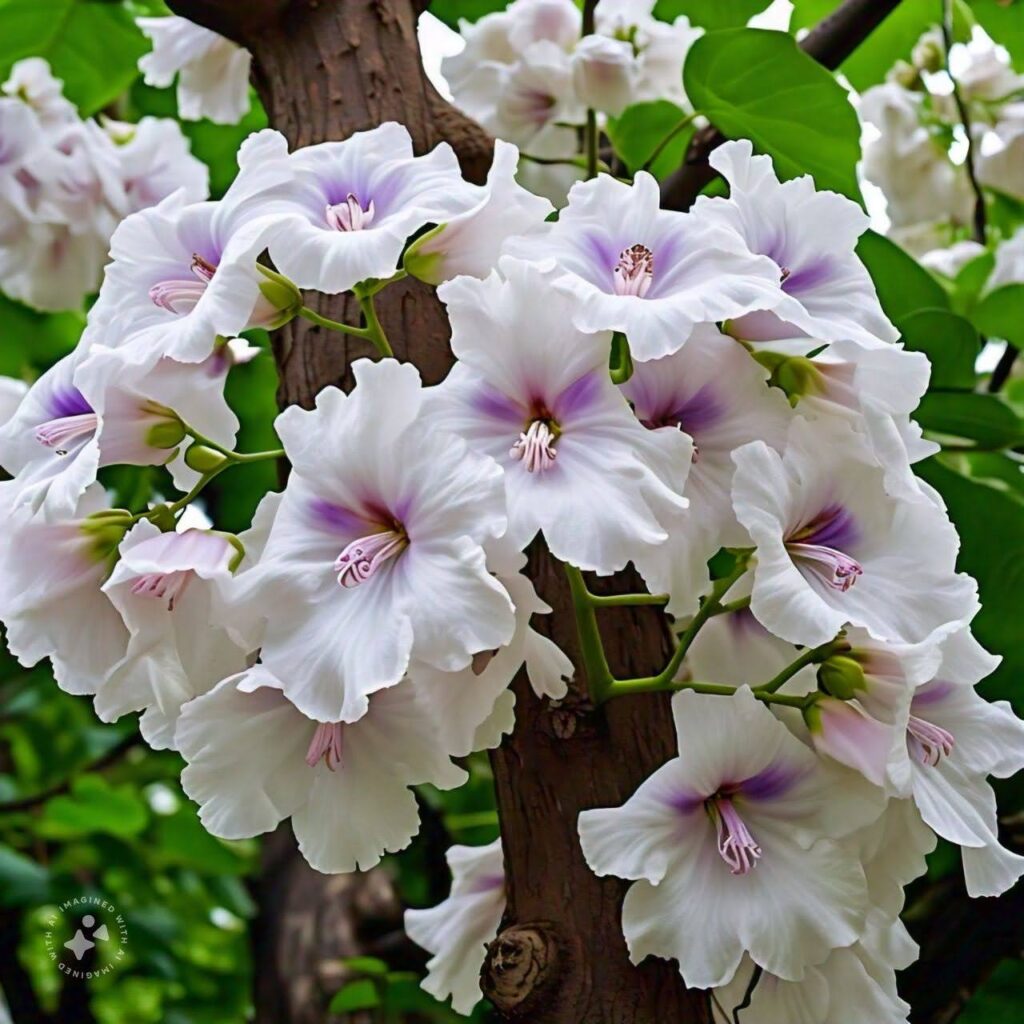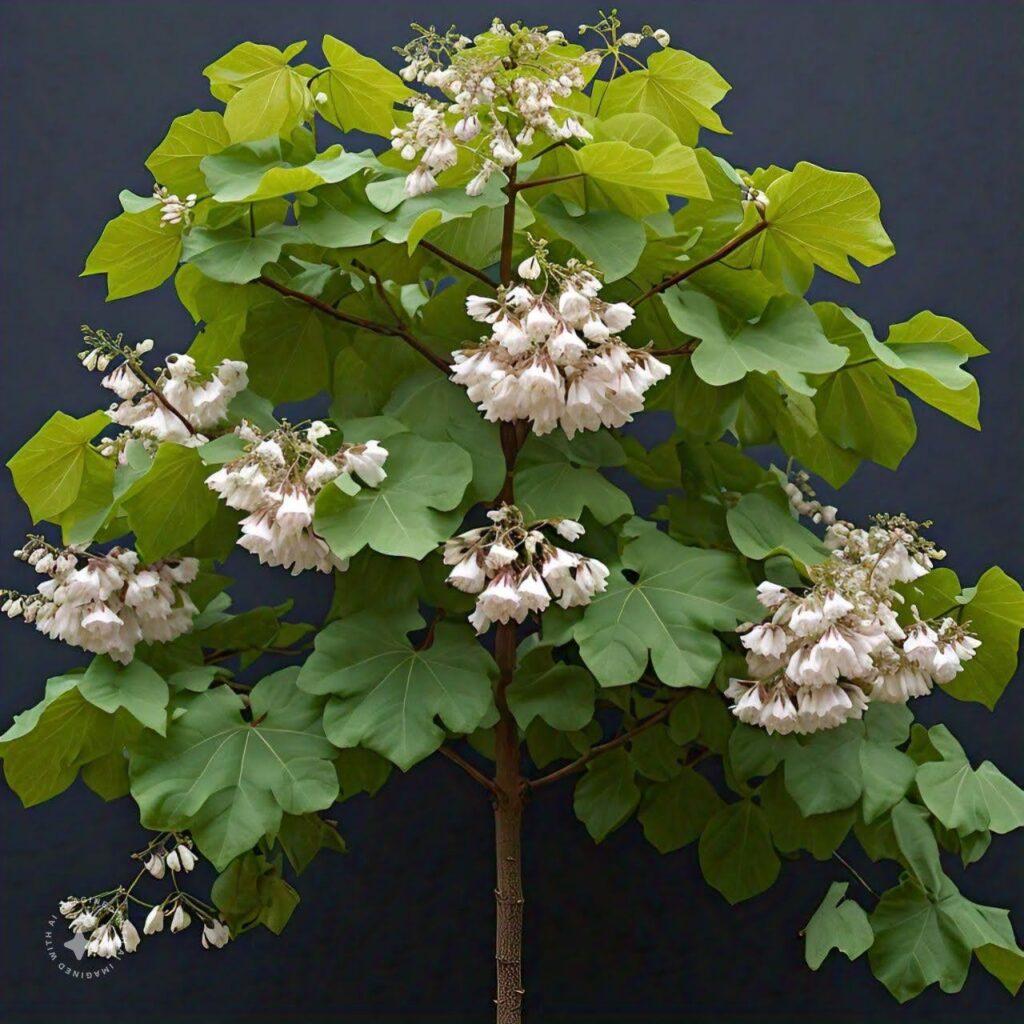Tree Plantation 2024:Paulownia Tomentosa, The Princess Tree
The Paulownia Tomentosa, Princess tree is a deciduous growing tree in the Paulowniaceae family. The tree is named in honour of Grand Duchess Anna Pavlovna of Russia (1795-1865), who was the daughter of Tsar Paul I of Russia and the wife of King William II of the Netherlands. The tree’s botanical name, Paulownia, is derived from her name.

The Princess Tree (Paulownia tomentosa) is native to Eastern Asia and is known for its fast growth rate, reaching heights of up to 50 feet (15 meters) in just a few years. It’s also known for its stunning purple flowers and large, velvety leaves Please write comprehensive information on this tree
Here’s a comprehensive overview of the Princess Tree (Paulownia tomentosa):
1. Paulownia Tomentosa :
- Paulownia Tomentosa :Botanical Name
- Paulownia tomentose
Family
- Paulowniaceae
Native Range
- Eastern Asia, specifically China, Japan, and Korea
Common Names
- Princess Tree, Empress Tree, Paulownia, Royal Paulownia

Paulownia Tomentosa
2. Physical Description
- Fast-growing, deciduous tree
- Can grow up to 50 feet (15 meters) tall
- Broad, rounded crown
- Large, velvety leaves (up to 2 feet/60 cm long)
- Showy, fragrant, purple flowers (up to 1 foot/30 cm long)
- Grayish-brown bark
Growth Habit
- Fast growth rate (up to 10 feet/3 meters per year)
- Can tolerate a range of soils and conditions
- Prefers full sun and well-drained soil
Hardiness
- USDA Hardiness Zones: 5-9
- Can tolerate temperatures as low as -20°F (-29°C)
Uses
- Ornamental tree for landscaping
- Shade tree
- Timber wood (used for furniture, musical instruments, and construction)
3. Interesting Facts
- Named in honor of Grand Duchess Anna Pavlovna of Russia
- Considered a symbol of good fortune and prosperity in Asian cultures
- Has been naturalized in many parts of the world, including North America
- Can be invasive in some areas due to its rapid growth and ability to outcompete native species
- The tree is known for its ability to survive wildfires because its roots can regenerate new, very fast-growing stems1.
- In Japan, the wood of this tree is important for creating the soundboards for stringed musical instruments, such as the koto and shamisen2.
4. Care and Maintenance
- Plant in well-drained soil and full sun
- Water regularly, but avoid overwatering
- Prune regularly to maintain shape and promote healthy growth
- Can be susceptible to pests and diseases, such as aphids and root rot
5. Paulownia Tomentosa: Major Growers and Exporters
The Princess Tree (Paulownia tomentosa) was introduced to Germany in the 18th century as an ornamental plant. It is believed to have been brought to Europe by German botanist and explorer Philipp Franz von Siebold, who discovered the tree in Japan in the 1830s3.
Today, Germany is a significant grower and exporter of Paulownia nursery saplings and seeds. These companies cultivate Paulownia trees in large quantities, producing high-quality saplings and seeds for both domestic and international markets. Germany’s favorable climate and long tradition of horticulture make it an ideal location for growing and exporting Paulownia nursery stock4.
Other Major Growing Countries
- China: Native to China, Paulownia is widely cultivated for its timber, medicinal properties, and ornamental value.
- United States: Paulownia is grown in many states, particularly in the southeastern regions, for timber, landscaping, and erosion control.
- Japan: Although native to China, Paulownia was introduced to Japan centuries ago and is now widely cultivated for its timber, ornamental value, and as a symbol of good fortune.
- Korea: Paulownia is grown in Korea for its timber, medicinal properties, and as an ornamental tree.
- Italy: Italy is a significant grower and exporter of Paulownia nursery stock, particularly in Tuscany and Umbria.
6. Factors Driving the Adoption of Paulownia (Paulownia tomentosa)
Several factors are driving the adoption of Paulownia (Paulownia tomentosa) in more countries:
- Fast Growth Rate: Paulownia is one of the fastest-growing trees, making it ideal for reforestation, afforestation, and timber production1.
- High Timber Value: Paulownia wood is highly prized for its strength, durability, and resistance to rot and insects2.
- Ornamental Value: The tree’s stunning purple flowers, large leaves, and attractive bark make it a popular choice for landscaping and gardening3.
- Medicinal Properties: Paulownia has been used in traditional medicine for centuries, particularly in Asia, for its anti-inflammatory, antibacterial, and antiviral properties4.
- Erosion Control: The tree’s extensive root system makes it effective in preventing soil erosion and landslides5.
- Climate Change Mitigation: Paulownia is a carbon sink, absorbing significant amounts of CO2, making it a valuable tool in the fight against climate change6.
- Drought Tolerance: The tree is relatively drought-tolerant, making it suitable for areas with limited water resources7.
- Pest and Disease Resistance: Paulownia has natural resistance to many pests and diseases, reducing the need for pesticides and other chemicals8.
- Soil Remediation: The tree can thrive in poor soil conditions, making it useful for soil remediation and rehabilitation9.
- Economic Benefits: Paulownia cultivation can provide significant economic benefits, particularly in rural areas, through timber production, nursery trade, and eco-tourism10.
These factors make Paulownia an attractive crop for many countries, driving its adoption and cultivation worldwide.
7. Key Industries and Products Using Paulownia

Paulownia (Paulownia tomentosa) is a versatile tree with various applications across several industries. Here are some of the key sectors and products where Paulownia is particularly important:
- Timber and Wood Products: Furniture, musical instruments, plywood, veneer, and construction materials11.
- Paper and Pulp Industry: Paulownia fibers are used to produce high-quality paper, cardboard, and tissue products12.
- Landscaping and Horticulture: Ornamental trees, shade trees, and garden plants.

Medicinal and Pharmaceutical Industry: Paulownia (Paulownia tomentosa) is utilized in various medicinal and pharmaceutical industries due to its bioactive compounds. Here are some key applications and industries: Medicinal Uses and Applications
- Traditional Medicine: In China, Paulownia has been used for centuries to treat conditions such as inflammatory bronchitis, tonsillitis, gonorrhea, traumatic bleeding, asthma, and hypertension1.
- Modern Pharmaceutical Research: Modern medical research has identified several potential applications for Paulownia as an antibacterial, anti-inflammatory, diuretic, antihypertensive, hemostatic, and insecticidal agent2.
- Bioactive Compounds: Various parts of the Paulownia tree, including leaves, flowers, fruits, wood, bark, roots, and seeds, contain bioactive compounds such as ursolic acid, matteucinol, paulownin, d-sesamin, syringin, and catalpinoside. These compounds have shown potential in treating a variety of ailments and diseases3.
Pharmaceutical Industries and Products
- Herbal Remedies: Paulownia extracts are used in herbal remedies for their anti-inflammatory and antibacterial properties.
- Nutraceuticals: The bioactive compounds in Paulownia are used in nutraceutical products aimed at improving health and preventing diseases.
- Cosmetics: Due to its antioxidant properties, Paulownia extracts are used in cosmetic products to promote skin health and reduce signs of ageing.
- Pharmaceuticals: Research is ongoing to develop pharmaceutical drugs from Paulownia’s bioactive compounds for treating various conditions, including hypertension and inflammatory diseases.
8. Notable Research and Development
- In Vitro Studies: Studies on Paulownia fortunei have shown that its seedlings, when inoculated with Agrobacterium rhizogenes, can produce hairy roots that synthesize bioactive compounds such as nucleosides (verbascosides), which have potential therapeutic applications3.
- Antioxidant Properties: The flavonoid contents and TROLOX Equivalent Antioxidant Capacity (TEAC) value in fresh and dry leaf extracts of Paulownia elongata suggest significant potential for advanced medicinal use3.
Paulownia’s diverse medicinal properties and bioactive compounds make it a valuable resource for the medicinal and pharmaceutical industries. Ongoing research continues to explore its full potential in modern medicine.
- Erosion Control and Environmental Restoration: Soil stabilization, landslide prevention, and ecological restoration.
- Agriculture and Forestry: Agroforestry, permaculture, and sustainable forestry practices.
- Composite Materials: Paulownia fibres are used to produce composite materials for automotive, aerospace, and sports equipment applications.
- Bioenergy and Biofuels: Paulownia is being researched as a potential feedstock for bioenergy and biofuel production.
- Textile Industry: Paulownia fibres can be used to produce sustainable textiles, fabrics, and clothing.
- Carbon Sequestration and Climate Change Mitigation: Paulownia is recognized as a valuable tool in carbon sequestration and climate change mitigation efforts.
9. Use in the Shipbuilding Industry
Paulownia (Paulownia tomentosa) is also used in the shipbuilding industry, particularly in the construction of:
- Ship Hulls: Paulownia wood is valued for its durability, strength, and resistance to rot and marine borers.
- Decking: Paulownia’s hardwood is used for decking due to its slip resistance, durability, and ability to withstand harsh marine environments.
- Superstructures: Paulownia is used in the construction of superstructures, such as cabins, bridges, and masts.
- Furniture and Fittings: Paulownia is used to make furniture, doors, and other fittings for ships due to its attractive grain and durability.
- Ship Repair and Maintenance: Paulownia is used for repair and maintenance work on ships due to its ability to withstand marine environments and resist rot and decay.
10. Countries and Regions Supported by the UN
- Africa: The UN supports Paulownia cultivation in African countries such as Ghana, Nigeria, and Kenya as part of its sustainable agriculture and forestry initiatives.
- Asia: The UN promotes Paulownia cultivation in Asian countries such as China, India, and the Philippines as part of its sustainable forest management and rural development initiatives.
- Latin America: The UN supports Paulownia cultivation in Latin American countries such as Brazil, Mexico, and Argentina as part of its sustainable agriculture and forestry initiatives.
- Pakistan: Pakistan is included in the list of countries supported by organizations like FAO, UNDP, GEF, UNCCD, and IFAD for various sustainable agriculture and forestry projects, including the cultivation of Paulownia.
11. Support from International Organizations
- Food and Agriculture Organization (FAO): The FAO promotes Paulownia as a valuable tree species for sustainable agriculture, forestry, and rural development in Pakistan1.
- United Nations Development Programme (UNDP): The UNDP supports Paulownia cultivation in Pakistan as part of its sustainable land management and poverty reduction initiatives1.
- Global Environment Facility (GEF): The GEF provides funding for projects that promote sustainable forest management, including Paulownia cultivation, in Pakistan2.
- United Nations Convention to Combat Desertification (UNCCD): The UNCCD supports Paulownia cultivation as a means to combat desertification and promote sustainable land management in Pakistan1.
- International Fund for Agricultural Development (IFAD): IFAD supports small-scale farmers in Pakistan to cultivate Paulownia as a means to improve their livelihoods and promote sustainable agriculture1.
12. Response to Paulownia Cultivation in Pakistan
Paulownia cultivation in Pakistan has shown promising results. Various trials and studies have been conducted to assess the growth and adaptability of different Paulownia species under local conditions. Here are some key points:
- Trials and Studies: Comparative trials of Paulownia species have been carried out at multiple sites, including Peshawar, Garhi Saeed, and Changa Manga. These trials have shown that species like Paulownia catalpifolia, P. fortunei, and P. elongata are particularly well-suited to the local climate and soil conditions3.
- Growth Performance: The data from these trials indicate that Paulownia species exhibit fast growth rates, making them ideal for reforestation and agroforestry programs. The trees have shown good diameter and height growth, which is crucial for timber production3.
- Adaptability: Paulownia trees have demonstrated the ability to thrive in various soil types and climatic conditions in Pakistan, provided they receive adequate irrigation3.
- Economic and Environmental Benefits: The cultivation of Paulownia in Pakistan is seen as a viable option for increasing wood production, improving soil health, and providing economic benefits to rural communities3.

Overall, the response to Paulownia cultivation in Pakistan has been positive, with ongoing efforts to expand its use in sustainable agriculture and forestry initiatives.
These incentives and support programs aim to promote sustainable development, reduce poverty, and improve livelihoods in developing countries, while also contributing to global efforts to combat climate change and promote sustainable land management.
Source:
1: North Carolina Extension Gardener Plant Toolbox 2: US Forest Service 3: Missouri Botanical Garden 4: Kidadl 5: Wikipedia 6: North Carolina Extension Gardener Plant Toolbox 7: US Forest Service 8: Missouri Botanical Garden 9: Kidadl 10: Wikipedia 11: North Carolina Extension Gardener Plant Toolbox 12: US Forest Service : Missouri Botanical Garden : Kidadl : Wikipedia : North Carolina Extension Gardener Plant Toolbox : US Forest Service : Missouri Botanical Garden : Kidadl : Wikipedia : North Carolina Extension Gardener Plant Toolbox : Missouri Botanical Garden : Kidadl : Wikipedia
1: FAO 2: UNDP 3: GEF 4: UNCCD 5: IFAD : FAO : UNDP : GEF
3: Paulownia species trials in Pakistan 2: GEF – Global Environment Facility 1: FAO in Pakistan
If you enjoyed this article, please like and share it with your friends, and don’t forget to Share your personal experience/observations thoughts and valuable suggestions to share for the education /benefit of others. Do subscribe to remain onboard and get more great content!
Tree Plantation 2024: Promising Hobby to Uplift Environment and Community
Tree Plantation 2024: Promising Hobby to Uplift Environment and Community
